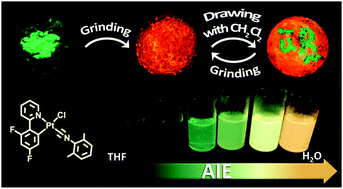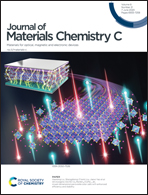Isomerism, aggregation-induced emission and mechanochromism of isocyanide cycloplatinated(ii) complexes†
Abstract
This work describes two series of neutral luminescent cyclometalated Pt(II) complexes incorporating chloride/isocyanide, [Pt(C^N)Cl(CNXyl)] (1–3), and alkynyl/isocyanide [Pt(C^N)(C![[triple bond, length as m-dash]](https://www.rsc.org/images/entities/char_e002.gif) CTol)(CNXyl)] (4–6) (CNXyl = 2,6-dimethylphenyl isocyanide) as auxiliary ligands. The variation of cyclometalating C^N ligand [C^N = C-deprotonated 2-phenylpyridine (ppy), 2,4-difluorophenylpyridine (dfppy) and phenylquinoline (pq)] was used to investigate its impact on the structural arrays and on their photophysical properties. The ppy-based complexes (4 and 5) were isolated as the trans-NC^N,CNR isomers, as precursors 1–3, whereas the pq complex 6 was selectively isolated as cis-NC^N,CNR, in agreement with calculations on 4 and 6. X-ray diffraction of 1, 3, and 4–6 confirms the configurations, revealing π⋯π/C^N⋯Xyl interactions in 1, 4 and 5. The photophysical properties of these compounds have been studied in all media. For 1–3, the monomer emission is assigned to 3IL/3MLCT, whereas for 4–6 it is assigned to mixed 3IL/3L′LCT/3MLCT with minor 3ML′′CT (L = C^N, L′ = C
CTol)(CNXyl)] (4–6) (CNXyl = 2,6-dimethylphenyl isocyanide) as auxiliary ligands. The variation of cyclometalating C^N ligand [C^N = C-deprotonated 2-phenylpyridine (ppy), 2,4-difluorophenylpyridine (dfppy) and phenylquinoline (pq)] was used to investigate its impact on the structural arrays and on their photophysical properties. The ppy-based complexes (4 and 5) were isolated as the trans-NC^N,CNR isomers, as precursors 1–3, whereas the pq complex 6 was selectively isolated as cis-NC^N,CNR, in agreement with calculations on 4 and 6. X-ray diffraction of 1, 3, and 4–6 confirms the configurations, revealing π⋯π/C^N⋯Xyl interactions in 1, 4 and 5. The photophysical properties of these compounds have been studied in all media. For 1–3, the monomer emission is assigned to 3IL/3MLCT, whereas for 4–6 it is assigned to mixed 3IL/3L′LCT/3MLCT with minor 3ML′′CT (L = C^N, L′ = C![[triple bond, length as m-dash]](https://www.rsc.org/images/entities/char_e002.gif) CTol, L′′ = CNXyl) character (TD-DFT calculations). The pq derivatives 3 and 6 do not show self-assembly tendency. However, the photoluminescence characteristics of the ppy-based complexes 1, 2, 4, and 5 are largely determined by intermolecular π⋯π aggregation, giving emissions significantly red-shifted with respect to the monomer in glasses (and also in PMMA and solids in 5), originating from 3ππ* (excimers or aggregates) or even M⋯M interactions in 2. The high degree of molecular aggregation on these complexes induces simultaneously phosphorescent aggregation induced emission (AIE), with stronger emissions in the solid state than in PMMA films and in fluid solutions and, reversible mechanochromic colour and emission changes, with remarkable redshift and decreased quantum yields. Powder X-ray diffraction studies on 1 and 5 suggest a reversible crystalline-to-amorphous phase transition as the mechanism of the mechanochromic process.
CTol, L′′ = CNXyl) character (TD-DFT calculations). The pq derivatives 3 and 6 do not show self-assembly tendency. However, the photoluminescence characteristics of the ppy-based complexes 1, 2, 4, and 5 are largely determined by intermolecular π⋯π aggregation, giving emissions significantly red-shifted with respect to the monomer in glasses (and also in PMMA and solids in 5), originating from 3ππ* (excimers or aggregates) or even M⋯M interactions in 2. The high degree of molecular aggregation on these complexes induces simultaneously phosphorescent aggregation induced emission (AIE), with stronger emissions in the solid state than in PMMA films and in fluid solutions and, reversible mechanochromic colour and emission changes, with remarkable redshift and decreased quantum yields. Powder X-ray diffraction studies on 1 and 5 suggest a reversible crystalline-to-amorphous phase transition as the mechanism of the mechanochromic process.



 Please wait while we load your content...
Please wait while we load your content...